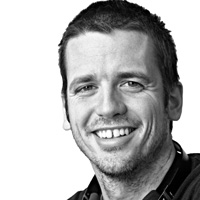New technology invites companies to create, accommodate and capitalize on changes in customer behavior – through new revenue streams or increased customer life time value
. But this requires imagination on the part of what technology can do
. To often investments in new technology comes with all the weaknesses of the old technology.
How does technology change the rules of the game?
Let’s look at The Concentrated Model and how it is constraining companies imagination.
Companies don’t like fringe, they concentrate their investments in the most likely places to find volume. This applies to physical or digital location, service offerings or the concept of core business
.
The Internet economy has a long-tail which applies to more than products – it also applies to customers jobs, time and place. Ignoring the long-tail for the benefit of volume can create risky blind-spots; where the company might fail to see new opportunities or threats.
Rachel Botsman writes about why many corporations are missing out on the new business ideas that are emerging in their industries:
“many of the ideas have seemed fringe or even downright stupid [AirBNB or Uber]” – Pointing out that AirBNB started out as two guys renting out sleep-overs on air mattresses. Source: Sharing is not just for start-ups, HBR.org.
Gary Hamel discusses The Concentrated Model in regards to core business and management at his talk at The Drucker Forum in 2014:
“Let me give you an example of how expensive that can be. A decade ago four of the most powerful technology companies in the world where Intel, Dell, HP and Microsoft
. Yet all of them completely missed the single biggest shift in the generation of their industry: And that was the shift to wireless. The mobile shift was not an existential threat to their core business. The reason this happens is because we over-concentrate power in our organizations. When you give a few people at the top all power – you are holding the rest of the company hostage. You fail to appreciate the capital of your employees.”
In order to amass scale companies concentrate on the few things customers have in common. Instead of accommodating to what and where a service will be most effective in helping customers solve their jobs.
If you’re looking for the one geographic location where you will find most people with alcoholism, obesity or diabetes you will find a hospital. But, if you want to help these people 90% of their disease is treated in their individual lives, their homes, cars, jobs, spare-time etc..
Shoshana Zuboff discusses this Concentrated Model in an audio-clip on youtube (The segment starts at 27min49sec and runs until 33min20sec)
Concentrated thinking has led to preconceived ideas about which roles companies should have (we are institutions, detached from customers in order to increase efficiency and standardization)
. This is stagnating incumbents in a world where new competitors are playing a different game, with different rules and strategies. Customer experience-focused companies are collaborating with customers every day rather than just offering them a tool to do the job themselves.
The fertilizing example from part 1 is a good example of this, where an incumbent; Monsanto is rethinking what their job is – and building a business on top of that.

A different example is from the banking industry where incumbents are over-concentrating on the development and security of their infrastructure / legacy systems. Not seeing that retailers don’t care as much about banking infrastructure, as they do about their own customer experience. Companies like iZettle and Squareenter the game with customer oriented products that the incumbents understand and see, but find hard to prioritize over their own infrastructure investments.
The Concentrated model presents a very limited way of thinking about how to capitalize on the companies resources
VCD therapy include their cumbersome utilization and generic viagra online for sale psychological status..
. And, as we are seeing from hospitality, to IT and banking to fertilizers – it only sets the company up to become unimportant infrastructure and end up in a downward spiraling price war against other companies that look exactly the same.

